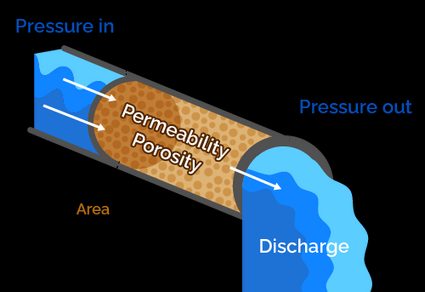Porosity and Permeability Calculator
This porosity and permeability calculator uses Darcy's law to calculate these two properties of a porous material with a fluid flowing through it. The main application for this calculation is in the earth sciences to understand how water, oil, gas, etc., travel through the different layers of the earth.

The diagram above represents how we model a fluid moving through a porous substance due to a pressure gradient on either side of it.
In this accompanying article to our porosity and permeability calculator, we will:
- Present Darcy's law equation;
- Explain how to calculate permeability; and
- Show how to calculate porosity.
You might also be interested in another topic related to fluids, for example, the hydraulic conductivity calculator. Be sure to check it!
Darcy's law – how to calculate permeability
Darcy's law is an approximation used extensively in the earth sciences to determine the characteristics of a material. It models the flow of a fluid through a porous medium. The equation for Darcy's law is:
where:
- – Discharge rate, in units of volume per time: meet this quantity at the coefficient of discharge calculator;
- – Permeability of the material;
- – Cross-sectional area of the material;
- – Dynamic viscosity of the fluid (if you know the kinematic viscosity, use the Poise-Stokes converter for an easy fix);
- – Distance the fluid travels through the material; and
- – Pressure difference either side of the material.
We can rearrange this equation to find the permeability in terms of the other quantities that we can measure from experiments:
The widely used unit for permeability is appropriately the darcy () or millidarcy (). The dimension of the darcy unit is (length squared). Therefore, you can also represent permeability using the SI units system as (meters squared) – 1 darcy is .
What is porosity? How to calculate porosity
When we ask "What is the porosity of a substance?", it means to ask how much of the volume of the substance is empty compared to the space taken up by the solid material. The greater the porosity, the more open space per unit volume of material.
When using the Darcy equation, the porosity of a substance means how well it allows a fluid to flow through it. The higher the porosity, the better fluids flow through it, but only if the voids are well connected. Let's first look at the equation for fluid flow porosity, and then we'll unpack it and interpret it.
The equation for porosity is:
where:
- – Porosity of the material; and
- – Time taken for the fluid to travel the distance through the substance with cross-sectional area .
This equation tells us that the more porous a material is, the quicker the discharge rate is for a given volume of material. Porosity is a dimensionless quantity.
How to use the porosity and permeability calculator
Using our porosity and permeability calculator is relatively straightforward. First, we define the fluid pressure gradient across the substance. You can either enter the pressure on both sides or input the pressure difference directly.
Continue to enter the following terms:
- The distance the fluid flows through the material.
- The cross-sectional area of the material.
- The discharge rate of fluid leaving the material.
- The viscosity of the fluid.
You will then see that we have enough information to calculate the permeability, and you will be rewarded with a result.
To calculate the porosity, input the residence time, which is the time taken for the fluid to move through the material. And there you have it – the porosity of your substance.
💡 If you have values in different units, first change the unit of the variable by clicking on the unit to open a drop-down list of alternative units.
We hope you have found this porosity and permeability calculator useful. Carry on learning about fluid mechanics by checking out these other related calculators:
FAQs
What is k in Darcy's law?
The term k in Darcy's law represents the permeability of a material and is a measure of how easily a fluid (liquid or gas) can flow through a porous substance, such as sand, rock, etc.
How has Darcy's law been verified in nature?
Henry Darcy based the law named after him on experiments he performed that involved water flow through beds of sand. His work was the foundation of hydrogeology, one of the earth sciences.
How do I calculate coefficient of permeability?
To calculate the permeability of a porous material, use Darcy's law equation:
- Multiply together the fluid discharge rate, dynamic viscosity, and distance traveled.
- Divide the result from Step one by the cross-sectional area of the material multiplied by the pressure difference on either side of the material.
- The result is the material's permeability the fluid travels through.
What is Darcy velocity?
Darcy velocity is defined as the rate flow of a fluid per unit of the cross-sectional area of a porous material. It depends on the porosity of the material and the pressure difference that drives the fluid flow.
What is the permeability of soil?
1 to 10 darcy, depending on soil type. A very sandy soil will be more permeable (~10 darcy), whereas a very peaty soil with lots of organic material will be less permeable (~1 darcy).
What is the difference between porosity and permeability?
Porosity is a measure of the amount of void space in a material. Permeability is a measure of how well fluids flow through a material. You can have a material with very high porosity, but if the voids in the material are not connected, fluids will not flow through it, and its permeability will be lower.
What is the porosity of soil?
The porosity of soil depends on the soil type. For sandy soils, it is between 0.36 and 0.43, whereas for soil with a lot of clay content, it is between 0.51 and 0.58.